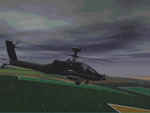 I
got the hook-up on Razorworks’ long-awaited attack helicopter simulation
Apache Havoc: a world class tag-team effort that is going to knock the
wind out of all you chopper-sim fans as well as your computers, literally.
The AH-64D Apache Longbow and Mi-28N Havoc-B are the front line of US’s
and CIS’s attack helicopter fleets, two machines that well embody the
strategies that they were intended to carry out, bristling with weaponry,
and designed with havoc in mind . . . no pun intended. So when Razorworks
decided to team up these two awesome machines in the same game, they
produced one of the most thoroughly playable sims I’ve seen in a while.
I
got the hook-up on Razorworks’ long-awaited attack helicopter simulation
Apache Havoc: a world class tag-team effort that is going to knock the
wind out of all you chopper-sim fans as well as your computers, literally.
The AH-64D Apache Longbow and Mi-28N Havoc-B are the front line of US’s
and CIS’s attack helicopter fleets, two machines that well embody the
strategies that they were intended to carry out, bristling with weaponry,
and designed with havoc in mind . . . no pun intended. So when Razorworks
decided to team up these two awesome machines in the same game, they
produced one of the most thoroughly playable sims I’ve seen in a while.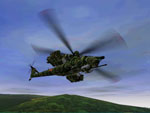 Having
both the Apache and Havoc at your control is only where the fun starts,
the mission design is the highlight for me. You, as the pilot, are not the
center of the action, but an integral part of a greater whole--action
happens all around you, whether or not you're looking. Though Apache Havoc is
also a fairly hardcore combat sim in its own right, its got a
serious set of problems for some less well-endowed gamers. Apache Havoc is
a system hog; the minimum requirements of a Pentium 166 and 32 Mb RAM are
completely insufficient if you want to have any fun with the game, I’d
only recommend this for higher end systems with lots of memory, speedy
processors, and big wallets to back ‘em up.
Having
both the Apache and Havoc at your control is only where the fun starts,
the mission design is the highlight for me. You, as the pilot, are not the
center of the action, but an integral part of a greater whole--action
happens all around you, whether or not you're looking. Though Apache Havoc is
also a fairly hardcore combat sim in its own right, its got a
serious set of problems for some less well-endowed gamers. Apache Havoc is
a system hog; the minimum requirements of a Pentium 166 and 32 Mb RAM are
completely insufficient if you want to have any fun with the game, I’d
only recommend this for higher end systems with lots of memory, speedy
processors, and big wallets to back ‘em up.
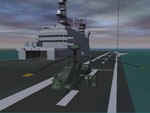 Part
of the problem is caused by the phenomenal exteriors that the game
features: there seems to be a win/lose situation here--you either get the
killer graphics or the ability to fly your chopper--it's up to you, but I’d
really prefer both. Even at 640x480 (the cockpit is always this
resolution, by the way), once you get into the city and the action gets
good, the game becomes unplayable, and before you know it you’ve piled
into some office complex. As I hinted, the terrain graphics are absolutely
beautiful, catering to low altitude flying: canyons and river-beds, trees
and buildings are provided for shelter and, most importantly, ambushes. I
love just holding a hover in a nicely concealed spot and waiting for the
enemy to unknowingly cruise by the action end of my 30mm meatgrinder.
After all, that’s what it's all about. And the weather effects are
varied along with the time of day--each time you play you get some
different combination. Its really nice when rain beads up on the canopy
and wipers helpfully remove the effect. I found myself looking forward to
flying in stormy weather with low ceilings-all this adds an essential
realism missing in many other games.
Part
of the problem is caused by the phenomenal exteriors that the game
features: there seems to be a win/lose situation here--you either get the
killer graphics or the ability to fly your chopper--it's up to you, but I’d
really prefer both. Even at 640x480 (the cockpit is always this
resolution, by the way), once you get into the city and the action gets
good, the game becomes unplayable, and before you know it you’ve piled
into some office complex. As I hinted, the terrain graphics are absolutely
beautiful, catering to low altitude flying: canyons and river-beds, trees
and buildings are provided for shelter and, most importantly, ambushes. I
love just holding a hover in a nicely concealed spot and waiting for the
enemy to unknowingly cruise by the action end of my 30mm meatgrinder.
After all, that’s what it's all about. And the weather effects are
varied along with the time of day--each time you play you get some
different combination. Its really nice when rain beads up on the canopy
and wipers helpfully remove the effect. I found myself looking forward to
flying in stormy weather with low ceilings-all this adds an essential
realism missing in many other games.
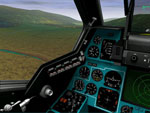 The
flight dynamics of both machines are great; there’s enough variation
between Apache and Havoc, performance and control-wise, to make it
interesting. Anyone not familiar with juggling the cyclic and collective,
essentially your pitch and throttle controls, respectively, won’t find
it too hard to handle with a little practice. Before long you can
coordinate well enough to stop on a dime, hold position, and use your
rudder to quickly turn and deliver a few Hellfires and neatly trounce a
lowly tank. Where the Havoc carries a slight advantage in performance, the
Apache takes the lead in technology. The Havoc’s mostly analog
instruments aren’t as easily read as the Apache’s digital displays.
But both feature some variation of helmet-instrument integration.
The
flight dynamics of both machines are great; there’s enough variation
between Apache and Havoc, performance and control-wise, to make it
interesting. Anyone not familiar with juggling the cyclic and collective,
essentially your pitch and throttle controls, respectively, won’t find
it too hard to handle with a little practice. Before long you can
coordinate well enough to stop on a dime, hold position, and use your
rudder to quickly turn and deliver a few Hellfires and neatly trounce a
lowly tank. Where the Havoc carries a slight advantage in performance, the
Apache takes the lead in technology. The Havoc’s mostly analog
instruments aren’t as easily read as the Apache’s digital displays.
But both feature some variation of helmet-instrument integration.
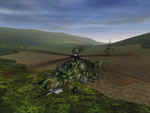 In
the Apache the Integrated Helmet And Display Sighting System (IHADSS)
follows your head movement, so you never have to worry about constantly
checking your instruments, and the same feature is found in the Havoc’s
Helmet-Mounted Sight (HMS). The Target Acquisition and Designation Sight
(TADS) controls (fancy way of saying radar) take up the entire keyboard
numberpad. But, I found that in this game, using the radar is a sure-fire
way to get quickly blown out of the sky-its like hand-feeding raw steak to
hungry bears-it hurts. Virtually every key of the keyboard is used, some
keys carrying up to three functions. Messing with all the controls and
cruising a few dozen feet off of rolling terrain can be overwhelming, so
the co-pilot can be set to handle a couple of the more arcane--though
essential--tasks such as counter measures and target identification.
In
the Apache the Integrated Helmet And Display Sighting System (IHADSS)
follows your head movement, so you never have to worry about constantly
checking your instruments, and the same feature is found in the Havoc’s
Helmet-Mounted Sight (HMS). The Target Acquisition and Designation Sight
(TADS) controls (fancy way of saying radar) take up the entire keyboard
numberpad. But, I found that in this game, using the radar is a sure-fire
way to get quickly blown out of the sky-its like hand-feeding raw steak to
hungry bears-it hurts. Virtually every key of the keyboard is used, some
keys carrying up to three functions. Messing with all the controls and
cruising a few dozen feet off of rolling terrain can be overwhelming, so
the co-pilot can be set to handle a couple of the more arcane--though
essential--tasks such as counter measures and target identification.
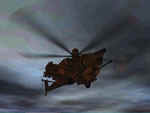 The
three campaigns are split into hypothetical melees in Cuba, Southern Asia’s
Golden Triangle, and Soviet Georgia. Now, as I mentioned before, the whole
deal here is the campaign setup. Once the campaign is started it
develops in real time. Nothing’s scripted, and your contribution to
the battle makes a difference; even when you're refueling or re-arming, the
clock is ticking. And when you crash you can watch the rest of the
mission fulfill itself without you. There is a super-wide variety of
targets: over 50 helicopters, combat aircraft, armored vehicles,
artillery, transports, and warships. Great fodder for hungry gunships.
Also, Apache Havoc has plenty of options and Multiplayer is supported for
virtually everything.
The
three campaigns are split into hypothetical melees in Cuba, Southern Asia’s
Golden Triangle, and Soviet Georgia. Now, as I mentioned before, the whole
deal here is the campaign setup. Once the campaign is started it
develops in real time. Nothing’s scripted, and your contribution to
the battle makes a difference; even when you're refueling or re-arming, the
clock is ticking. And when you crash you can watch the rest of the
mission fulfill itself without you. There is a super-wide variety of
targets: over 50 helicopters, combat aircraft, armored vehicles,
artillery, transports, and warships. Great fodder for hungry gunships.
Also, Apache Havoc has plenty of options and Multiplayer is supported for
virtually everything.
The only way that you’re going to get sick of this game is if you get
tired of flying choppers. There are so many different ways that you can
enter combat, complete your mission, and mess around in the combat scene,
that the game is for all intents and purposes infinitely playable. The only
problem here is the steep performance requirements.

 I
got the hook-up on Razorworks’ long-awaited attack helicopter simulation
Apache Havoc: a world class tag-team effort that is going to knock the
wind out of all you chopper-sim fans as well as your computers, literally.
The AH-64D Apache Longbow and Mi-28N Havoc-B are the front line of US’s
and CIS’s attack helicopter fleets, two machines that well embody the
strategies that they were intended to carry out, bristling with weaponry,
and designed with havoc in mind . . . no pun intended. So when Razorworks
decided to team up these two awesome machines in the same game, they
produced one of the most thoroughly playable sims I’ve seen in a while.
I
got the hook-up on Razorworks’ long-awaited attack helicopter simulation
Apache Havoc: a world class tag-team effort that is going to knock the
wind out of all you chopper-sim fans as well as your computers, literally.
The AH-64D Apache Longbow and Mi-28N Havoc-B are the front line of US’s
and CIS’s attack helicopter fleets, two machines that well embody the
strategies that they were intended to carry out, bristling with weaponry,
and designed with havoc in mind . . . no pun intended. So when Razorworks
decided to team up these two awesome machines in the same game, they
produced one of the most thoroughly playable sims I’ve seen in a while.